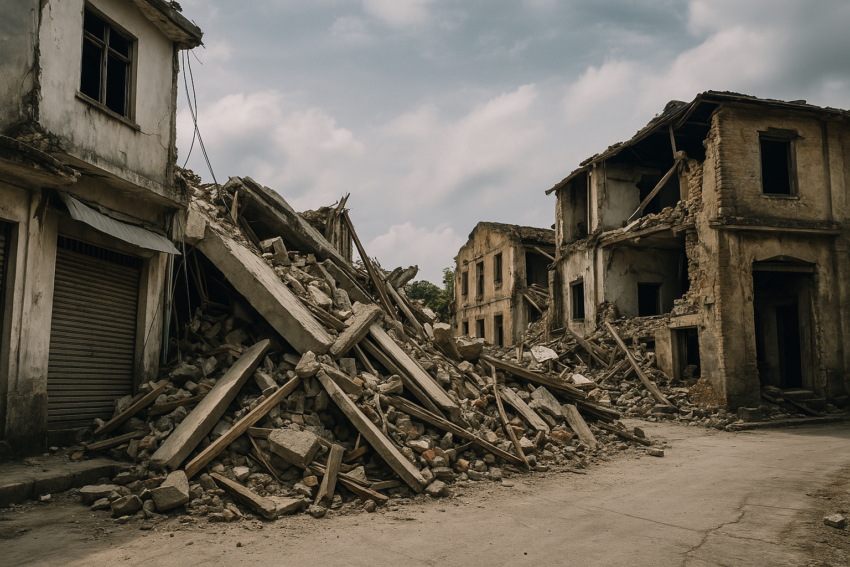On March 28, 2025, Myanmar was struck by a devastating 7.7 magnitude earthquake that has added another layer of suffering to a nation already grappling with the horrors of civil war. The earthquake, which also affected neighboring Thailand, has amplified the humanitarian crisis in the region. While Myanmar’s civil conflict has already created deep divisions, this disaster has compounded the challenges, making the delivery of aid more difficult and the impact more devastating.
The Timing of the Earthquake: A Devastating Blow
The earthquake hit Myanmar at a particularly critical time, intensifying an already dire situation. Myanmar has been embroiled in civil war since the 2021 military coup, with ethnic armed groups and resistance factions battling against the junta. The powerful earthquake struck near the northern border region, close to Chiang Mai, Thailand, and Kachin State, Myanmar, two areas that have been severely affected by both natural and human-made disasters. The timing couldn’t be worse: the earthquake hit as Myanmar was already reeling from escalating violence and a fragile economy, pushing the country into further instability.
The Strain on Myanmar and Thailand
As Myanmar faces the devastating consequences of the earthquake, Thailand, which shares a border with Myanmar, has also been impacted by the tremors. In Thailand’s northern regions, cities such as Chiang Mai and Chiang Rai have experienced infrastructure damage, particularly to roads and buildings, adding to the already precarious situation in the region. Refugees from Myanmar, as well as the Thai population, are now grappling with the effects of a natural disaster on top of ongoing conflicts that have strained local resources.
The people in both countries fear that the earthquake is merely the beginning of a prolonged ordeal. As aftershocks continue to rattle the region, both Myanmar and Thailand are bracing for the long-term challenges of rebuilding, caring for the injured, and managing the humanitarian fallout.
Who Will Provide Aid? International Support in the Face of Military Control
Aid is essential for both Myanmar and Thailand, but the delivery process is more complicated than in typical disaster relief efforts due to Myanmar’s ongoing civil war and the military junta’s firm grip on power.
Humanitarian aid will likely come from both international and regional sources, with organizations like the United Nations, USAID, World Health Organization, and various NGOs gearing up to assist. However, Myanmar’s junta has a history of controlling aid distribution, particularly to areas held by ethnic armed groups and resistance forces. This will likely lead to a situation where aid is disproportionately allocated to areas controlled by the military, while rebel-held regions will continue to struggle for access to vital supplies.
China, Myanmar’s main ally, has already pledged assistance, and it is likely that they will play a significant role in both humanitarian and infrastructure rebuilding efforts. China’s influence in Myanmar could help smooth over the logistical challenges of distributing aid across the fractured country.
While international aid organizations and governments such as those in the United States, Japan, and India are likely to provide some assistance, the junta’s control over distribution means that aid may be used strategically to shore up the regime’s influence in key areas and punish regions that resist its rule.
The Junta’s Control Over Aid Distribution
Myanmar’s military government, already accused of human rights abuses and international sanctions, is expected to exercise tight control over the flow of aid. The junta may try to prevent aid from reaching ethnic groups and rebel-held territories, exacerbating their suffering and increasing resentment toward the central government. This strategy is not unprecedented; the military has long used control over resources as a means of power consolidation.
This is particularly concerning given the widespread poverty and need for medical assistance across Myanmar, especially in war-torn areas. While aid agencies may try to reach the most vulnerable, the junta’s control will likely shape which regions receive the assistance they need.
The Aftermath in Myanmar and Thailand: A Long Road to Recovery
The earthquake’s aftermath has caused significant damage to infrastructure, including collapsed buildings, severed communication lines, and disrupted transportation routes. In Myanmar, the most affected regions are those already struggling with civil conflict, making rebuilding efforts even more difficult.
As the situation evolves, the Burmese people and Thai citizens alike fear that their struggle is far from over. Myanmar’s civilian population, already under the thumb of the military regime, is facing the added burden of natural disaster while enduring the brutalities of war. Meanwhile, Thailand’s northern provinces are now dealing with a combination of natural and refugee crises that have strained both humanitarian resources and local governments.
For those in the war-torn areas of Myanmar, the earthquake has added to the long list of challenges: displacement, famine, lack of medical care, and increasing military pressure. Similarly, those in Thailand’s affected regions now face the possibility of overcrowded refugee camps and overwhelmed emergency response systems.
The Road to Healing Is Long and Uncertain
The devastating 7.7 magnitude earthquake in Myanmar has exposed the fragility of both the country and the region, as Myanmar’s civil war continues to complicate relief efforts. The earthquake has not only deepened the crisis within Myanmar but also strained neighboring Thailand, making the path to recovery uncertain.
As the world looks on, the international community must be prepared to help both Myanmar and Thailand navigate the challenges of aid distribution, reconstruction, and recovery. However, with Myanmar’s military junta controlling much of the aid flow, the likelihood that those in need will receive sufficient assistance is slim. For both countries, the road to recovery will be long, filled with political, humanitarian, and economic hurdles.


